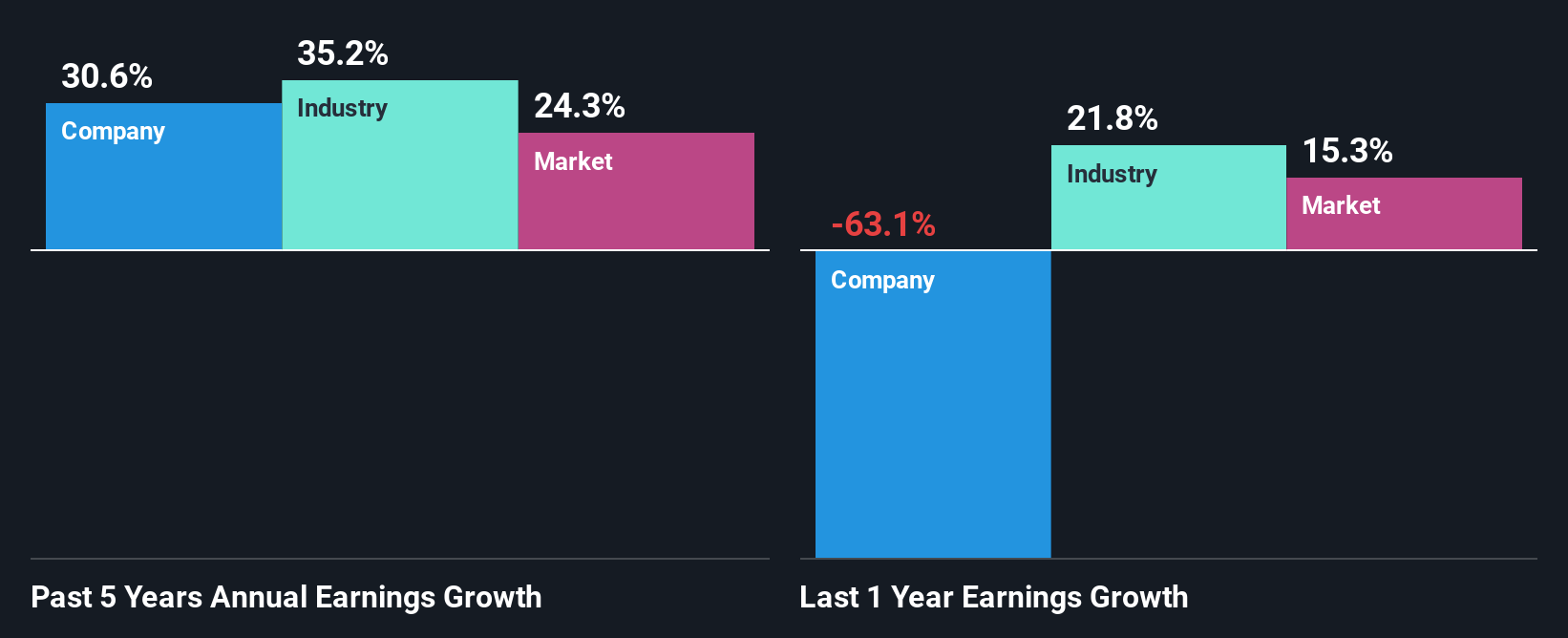Is HEG Limited's (NSE:HEG) Recent Stock Performance Influenced By Its Fundamentals In Any Way?
Most readers would already be aware that HEG's (NSE:HEG) stock increased significantly by 20% over the past three months. Given that stock prices are usually aligned with a company's financial performance in the long-term, we decided to study its financial indicators more closely to see if they had a hand to play in the recent price move. Specifically, we decided to study HEG's ROE in this article.
ROE or return on equity is a useful tool to assess how effectively a company can generate returns on the investment it received from its shareholders. Put another way, it reveals the company's success at turning shareholder investments into profits.
How Is ROE Calculated?
ROE can be calculated by using the formula:
Return on Equity = Net Profit (from continuing operations) ÷ Shareholders' Equity
So, based on the above formula, the ROE for HEG is:
2.6% = ₹1.2b ÷ ₹45b (Based on the trailing twelve months to March 2025).
The 'return' refers to a company's earnings over the last year. Another way to think of that is that for every ₹1 worth of equity, the company was able to earn ₹0.03 in profit.
See our latest analysis for HEG
Why Is ROE Important For Earnings Growth?
So far, we've learned that ROE is a measure of a company's profitability. Depending on how much of these profits the company reinvests or "retains", and how effectively it does so, we are then able to assess a company’s earnings growth potential. Assuming all else is equal, companies that have both a higher return on equity and higher profit retention are usually the ones that have a higher growth rate when compared to companies that don't have the same features.
HEG's Earnings Growth And 2.6% ROE
As you can see, HEG's ROE looks pretty weak. Not just that, even compared to the industry average of 13%, the company's ROE is entirely unremarkable. Despite this, surprisingly, HEG saw an exceptional 31% net income growth over the past five years. We believe that there might be other aspects that are positively influencing the company's earnings growth. For instance, the company has a low payout ratio or is being managed efficiently.
Next, on comparing HEG's net income growth with the industry, we found that the company's reported growth is similar to the industry average growth rate of 35% over the last few years.

The basis for attaching value to a company is, to a great extent, tied to its earnings growth. What investors need to determine next is if the expected earnings growth, or the lack of it, is already built into the share price. By doing so, they will have an idea if the stock is headed into clear blue waters or if swampy waters await. Is HEG fairly valued compared to other companies? These 3 valuation measures might help you decide.
Is HEG Making Efficient Use Of Its Profits?
HEG's three-year median payout ratio is a pretty moderate 32%, meaning the company retains 68% of its income. This suggests that its dividend is well covered, and given the high growth we discussed above, it looks like HEG is reinvesting its earnings efficiently.
Moreover, HEG is determined to keep sharing its profits with shareholders which we infer from its long history of paying a dividend for at least ten years. Our latest analyst data shows that the future payout ratio of the company over the next three years is expected to be approximately 28%. Still, forecasts suggest that HEG's future ROE will rise to 19% even though the the company's payout ratio is not expected to change by much.
Conclusion
Overall, we feel that HEG certainly does have some positive factors to consider. With a high rate of reinvestment, albeit at a low ROE, the company has managed to see a considerable growth in its earnings. That being so, the latest analyst forecasts show that the company will continue to see an expansion in its earnings. Are these analysts expectations based on the broad expectations for the industry, or on the company's fundamentals? Click here to be taken to our analyst's forecasts page for the company.
Have feedback on this article? Concerned about the content? Get in touch with us directly. Alternatively, email editorial-team (at) simplywallst.com.
This article by Simply Wall St is general in nature. We provide commentary based on historical data and analyst forecasts only using an unbiased methodology and our articles are not intended to be financial advice. It does not constitute a recommendation to buy or sell any stock, and does not take account of your objectives, or your financial situation. We aim to bring you long-term focused analysis driven by fundamental data. Note that our analysis may not factor in the latest price-sensitive company announcements or qualitative material. Simply Wall St has no position in any stocks mentioned.
 Wall Street Journal
Wall Street Journal